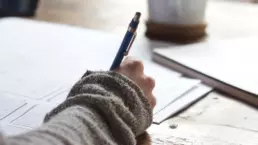A number of the world’s famous brands feature animals in their identity — an age–old technique of implying characteristics to a brand, such as the confident and brave lion, or a loyal pet dog.
Here are some of my favourite examples of animals in logo design.
HMV
HMV stands for His Master’s Voice, a painting by Francis Barraud. Francis’ late brother’s dog, named Nipper, listens intently to a recording on a wind–up gramophone of his owner.

His Master’s Voice by Francis Barraud (1899)
The Gramophone Company didn’t begin to use the mark until 1909, and wasn’t formally known as ‘HMV’ for some time afterwards. However it was referred to as that by the public well before this — testament to its effectiveness and popularity as a logo.

The identity has developed over the years, with Nipper taking the form of a more simple, streamlined beast.
Fundación María Jesús

Designed by NUZ Estudio
I fell in love with this logo / illustration the first time I saw it. It’s a charming drawing, but the colours and the way everything works into a circle also help to make this live in the memory.
Nestlé

Designed by unknown
This graphic originated from a coat of arms belonging to the family of Henri Nestlé, which featured a bird sitting in its nest. With his company specialising in infant cereal products, in 1868 he adapted this by adding three young birds fed by their mother.
Penguin Books

Originally designed by Edward Young (1935). Redesigned by Jan Tschichold (1949). And refined again for the digital age by Angus Hyland (2003)
In 1935, frustrated by the lack of reading material whilst waiting on the platform of Exeter Station, Allen Lane, of the publisher Bodley Head, hit upon the idea of producing a new range of quality, but affordable paperbacks. Named Penguin Books at the suggestion of his secretary, the venture required a ‘dignified, but flippant’ symbol. 21‐year old Edward Young was sent to Regent’s Park with orders to make sketches of the flightless residents.
Young returned from the zoo exclaiming “My God, how those birds stink!”, but it turned out to be an extremely worthwhile exercise. When Lane’s sixpence Penguin Books entered the world, they proudly bore one of Young’s sketches on the cover. The symbol has undergone many refinements and variations over the following years, with Jan Tschichold redrawing it as part of his Penguin Book redesign in 1949.
World Wide Fund for Nature

Designed by Sir Peter Scott (1961) — redesigned by Landor Associates (1986)
“We wanted an animal that is beautiful, is endangered, and one loved by many people in the world for its appealing qualities. We also wanted an animal that had impact with black and white printing to save money on printing costs.” Sir Peter Scott
Lacoste

Designed by Robert George (1933)
In the late 1920’s, French tennis star Jean Rene Lacoste was nicknamed ‘the Crocodile’ for his tenacious style. As well as winning seven Grand Slam singles titles, he was well known for his tennis shirt introduced in 1929.

Jean Rene Lacoste
After his career, Lacoste co-founded a sportswear company, making effective use of his fame in this new venture. Lacoste found great success in selling variations of his shirt, and patented the first tubular steel racquet in 1963.
Premier League

Designed by DesignStudio (2016)
Launched for the 2016–17 season, alongside a vibrant colour scheme; the new Premier League logo certainly made waves.
Playboy

Designed by Arthur Paul (1953)
In use since the second ever issue of Playboy magazine, interestingly, this mark has never been altered. The designer chose the subject of a rabbit for its humorous sexual connotation. A resoundingly successful design, the Playboy logo is easily one of the most recognisable logos ever.
Ferrari

Some logos have stories, and then there is Ferrari!
“As my trademark, I continued to use the rampant horse that had been used on the cars of the old Scuderia Ferrari.” Enzo Ferrari

Count Francesco Baracca
The horse was orignally the symbol of legendary ‘asso’ (ace), Count Francesco Baracca who served in the Italian Air Force during World War I. Baracca was shot down and killed on 19th June 1918, after winning 34 duels and many team victories. The Count used the prancing horse on his aircraft, as his squad was enrolled in a Cavalry regiment (Air Forces were in their infancy at this time and had no separate administration).
“In 1923, when competing in the first Circuito del Savio, at Ravenna, I made acquaintance of Count Enrico Baracca, the hero’s father. I was subsequently introduced to the ace’s mother, the Countess Paolina Baracca, who one day said to me: Ferrari, why don’t you put my son’s rampant horse on your car? It will bring you luck. I still have Baracca’s photograph, with his parents dedication in which they entrust the horse to me.
“The horse was, and has remained, black; whilst I myself added the gold field, this being the color of Modena” Enzo Ferrari
—
Header Image: Bravo Prince on Unsplash.







